Dover and Canterbury
We reached Dover shortly after sunset on Friday and ate momos at a very nice Nepalese restaurant. Our hotel was also very cosy, which more than made up for the fact that my friend and I had to share a bed. He reminisced about the coffee they served in the morning for many days.
We left the
inn shortly after eight o’clock in the morning, walking up the Dame Vera Lynn
Way to the top of the famed White Cliffs of Dover. The weather was sunny with a
very healthy dose of wind, which threatened to carry off small dogs and erected
invisible walls for birds attempting to fly along the coast. Contrary to my
fears, we were able to see plenty rock faces even while standing on top of
them, as the sea bites into the land every now and then and exposes them to
landlubbers. It took us about two hours to get to Saint Margaret’s Beach, where
my Czech phone carrier sent me a message welcoming me back to the EU. I was not
able to catch any wi-fi on either of my cards for another half an hour.
The way back
to Dover and Dover Castle was not clear on Google maps, and we could not quite
figure out how to get there without walking all the way down the cliffs and
back up again. We asked for directions first at the national trust gift shop
and again at the parking lot, but the pathways they sent us down led to a dead
end. There, a pair of local women with a couple of chihuahuas told us we would
be best off following the main road to the entrance of the castle. They also
said we must be giving off very positive energy, because their usually yappy
dogs came running towards us and let themselves be petted.
We finally
made it to Dover Castle around noon. Its highlights include a massive tower
where you feel like your head is about to be blown off by the wind, a Norman
church, and a remarkably well-preserved Roman lighthouse. The entry fee was
almost as exorbitant as the one at Stonehenge, which convinced me to buy an
English Heritage Pass. I have since calculated that it should pay for itself in
about two months, but I will be keeping a little spreadsheet just to make sure.
We ate
lunch at the White Horse, reportedly the oldest pub in Dover, where my friend
had his first fish and chips, and I had my first English-pub-style curry. They
were both very good. We then went over to the train station to print our
tickets to Canterbury. Due to some rail work, we were sent on a direct bus
driven by a grouchy old man with an incongruous affection for little dogs
(these were carried by two women who greeted him but did not board the bus). In
true Canterbury Tales fashion, we sat right behind a group of five women
and their gay friend, all animatedly telling each other stories and talking
about their experiences in our modern-day plague.
Upon our
arrival in Canterbury, we scaled the walls of the city and headed northeast. The
town’s medieval fortifications are used by tourists and locals alike to get
from one point to another; our destination was Saint Augustine’s Abbey. This
massive UNESCO-listed complex was founded in 598 and operated for almost one
thousand years until its dissolution during the Reformation. What remains of it
today are some scenic ruins from across the centuries.
By sheer
luck, we left the Abbey early enough that we made it to Canterbury Cathedral
just five minutes before its last entry. I was not aware of this rule, as most
materials I read only mentioned it closed at five. The Cathedral was massive
and ornate, as one might expect of the seat of the Archbishop of Canterbury,
the principal leader of the Church of England and the symbolic head of the
worldwide Anglican Communion. The pulpit was probably the prettiest I have seen
in England so far, with detailed and painted woodcarvings.
We walked
around the cathedral grounds for a while before heading for the Dane John
Mound, from which we watched the city while the sun set. The mound was originally
a Roman burial ground, converted into a motte-and-bailey castle by William the
Conqueror. A monument was built on top of the mound in the 19th
century to commemorate James Simmons, who converted the site into public
gardens.
We left
Canterbury in the morning after a quick excursion to a few sites we did not see
the day before. We made a short stop at Saint Martin’s Church, which prides
itself on being “the oldest parish church in the English-speaking world” and
“the oldest church building in Britain still in use as a church.” The church
predates the arrival of Saint Augustine in 597, having been the private chapel
of Queen Bertha. The Frankish princess was instrumental in spreading
Christianity throughout Britain, as she encouraged her husband’s conversion.
From the Church of Saint Martin, we walked over to the famed Crooked House and the bizarrely decorated Beaney House of Art and Knowledge. I caught a glimpse of the first line of the Canterbury Tales at the Chaucer statue, which meant that of course I had to recite for my friend the first eighteen lines that we were made to memorise in undergrad. Our last stop in Canterbury was at the Westgate Towers.
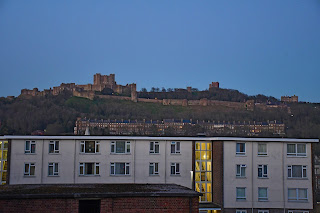









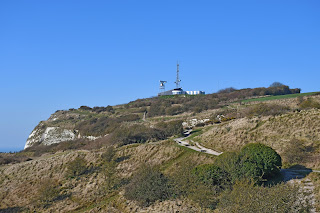









































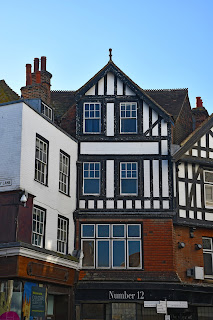































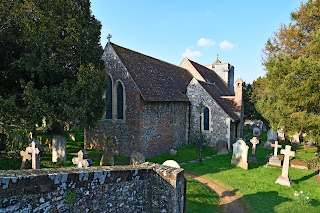













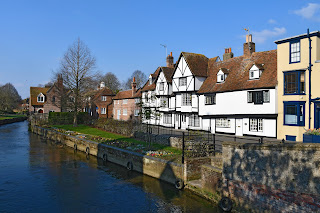



Comments
Post a Comment